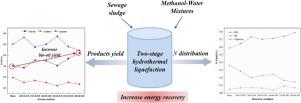The Journal of Supercritical Fluids ( IF 3.4 ) Pub Date : 2020-10-22 , DOI: 10.1016/j.supflu.2020.105094 Yao Tong , Tianhua Yang , Bingshuo Li , Xingping Kai , Rundong Li

|
Hydrothermal liquefaction could be a promising technology to convert sewage sludge into bio-oil for energy recovery. In this study, in order to obtain the maximum yield of bio-oil and improve the energy recovery of sludge, the influence of temperature and residence time on the multi-temperature continuously liquefaction of sludge in methanol-water mixed solvents was investigated. The results showed that the two-stage liquefaction significantly affected the yield, elemental composition, higher heating value, energy recovery and chemical composition of bio-oil. By optimizing the reaction conditions of hydrothermal liquefaction, the maximum utilization of sludge resources was realized. The maximum yield (42.2 %) and ester content (41.8 %) of bio-oil were obtained when the reaction conditions were 260 °C, 40 min for the first stage and 340 °C, 40 min for the second stage. The migration and transformation of nitrogen indicated that nitrogen elements were mainly concentrated in the liquid product and the N-heterocyclic compounds are the main forms of nitrogen in bio-oils.
中文翻译:

中低温甲醇-水混合溶剂中污水污泥的两级液化
水热液化可能是将污水污泥转化为生物油以回收能量的有前途的技术。为了获得最大的生物油产量并提高污泥的能量回收率,研究了温度和停留时间对污泥在甲醇-水混合溶剂中的多温度连续液化的影响。结果表明,两阶段液化显着影响了生物油的产率,元素组成,较高的热值,能量回收率和化学组成。通过优化水热液化反应条件,实现了污泥资源的最大利用。当反应条件为260°C,第一步40分钟和340°C时,获得生物油的最大产率(42.2%)和酯含量(41.8%),第二阶段40分钟。氮的迁移和转化表明,氮元素主要集中在液体产物中,N-杂环化合物是生物油中氮的主要形式。











































 京公网安备 11010802027423号
京公网安备 11010802027423号